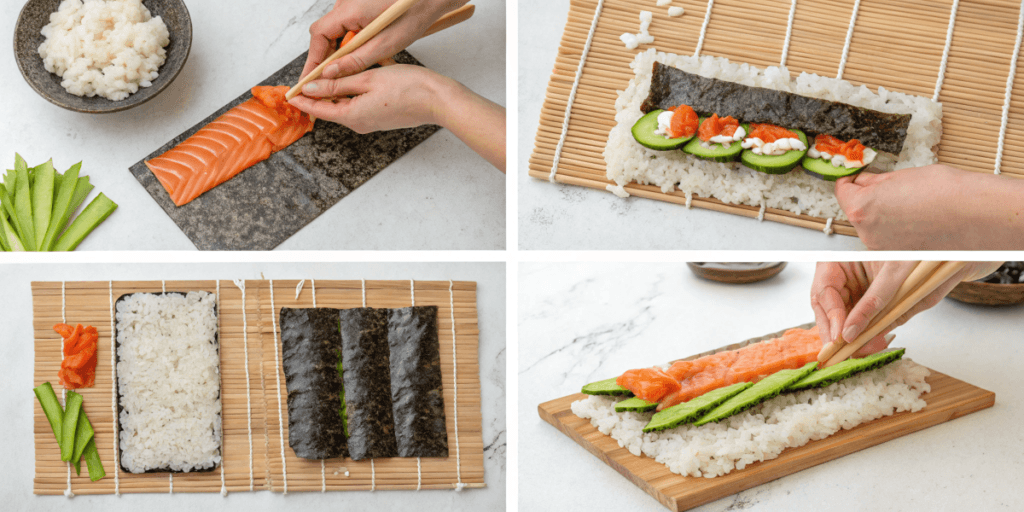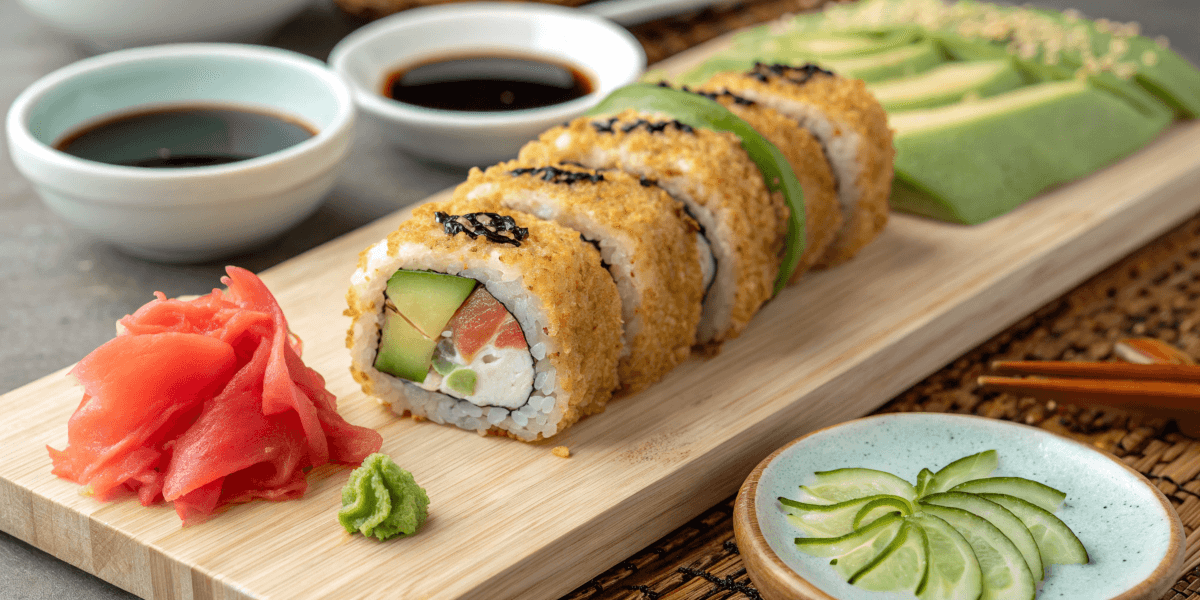Sushi is a culinary art, and one of its hidden gems is the salmon skin roll. This delightful roll combines crispy, umami-packed salmon skin with perfectly seasoned rice, fresh veggies, and a touch of sauce for a flavor explosion. From its nutritional benefits to preparation techniques and creative variations, this article dives into everything you need to know about making and enjoying this delicious treat. Whether you’re a seasoned sushi enthusiast or just starting, you’re in for a treat!
What is a Salmon Skin Roll?
What Defines a Salmon Skin Roll?
A salmon skin roll is a type of sushi roll that highlights the crispy, savory goodness of salmon skin. Wrapped in a sheet of nori (seaweed), it’s typically filled with sushi rice, cucumber, and avocado, complemented by the crunch and rich flavor of salmon skin. Often drizzled with eel sauce for a touch of sweetness, it’s a harmonious blend of textures and tastes.
Explore more about the origins of sushi in our article on white salmon, which discusses sustainable seafood choices.
The Origin and Cultural Significance of Sushi Rolls
Sushi rolls, or makizushi, originated in Japan as a convenient way to enjoy fish with rice and vegetables. While the salmon skin roll is more of a modern invention, it reflects the traditional Japanese ethos of using every part of the fish, reducing waste, and maximizing flavor. Over time, this roll has gained popularity worldwide for its innovative twist on sushi.
Why Use Salmon Skin? Health and Taste Benefits
Salmon skin isn’t just a byproduct; it’s a treasure trove of flavor and nutrition. Crisped to perfection, it provides an irresistible crunch that contrasts beautifully with the softness of the sushi rice. Plus, salmon skin is rich in omega-3 fatty acids, essential for heart and brain health, making this roll a delicious and healthy choice.
The Nutritional Benefits of Salmon Skin
Rich in Omega-3 Fatty Acids and Other Nutrients
Did you know that salmon skin is packed with omega-3 fatty acids? These healthy fats are great for your heart, brain, and overall well-being. Including them in a salmon skin roll is a clever way to enjoy sushi while reaping nutritional benefits. Omega-3s help lower inflammation, improve mental focus, and may even boost your mood. Additionally, salmon skin is a source of protein, B vitamins, and selenium—essential nutrients that keep your body running smoothly.
Low-Calorie Crunch: A Healthy Alternative
When you’re craving something crunchy but want to avoid unhealthy fried snacks, salmon skin is a great option. With fewer calories than most fried foods and zero trans fats, it delivers guilt-free satisfaction. By incorporating it into a salmon skin roll, you get a delicious and healthy sushi treat that satisfies both your taste buds and nutritional needs. Pair it with fresh vegetables like cucumber and carrot for an even healthier bite!
Check out our guide to making crispy fish toppings for more inspiration.
Why Salmon Skin is a Superfood Ingredient
Salmon skin’s nutritional profile makes it a true superfood. Beyond the omega-3 fatty acids and protein, it’s rich in collagen, which is excellent for skin elasticity and joint health. Whether you’re a fitness enthusiast or simply trying to eat cleaner, adding a salmon skin roll to your diet is a delicious and nutrient-packed choice.
How to Prepare Salmon Skin for Rolls
Choosing the Best Salmon Skin
The first step to making a mouthwatering salmon skin roll is picking the right salmon. Always opt for fresh, high-quality salmon, preferably from a trusted source. Wild-caught salmon is often preferred for its firmer texture and richer flavor. When selecting the skin, look for even thickness and ensure it’s clean and free of scales. These details make all the difference in achieving that perfect crunch.
Learn more tips for selecting seafood in our detailed recipe collections.
Step-by-Step Guide to Crisping Salmon Skin
- Prep the Skin: Clean the salmon skin thoroughly and pat it dry with a paper towel. Moisture is the enemy of crispiness, so make sure it’s as dry as possible.
- Add Seasoning: Sprinkle a pinch of sea salt and a dash of pepper over the skin for enhanced flavor.
- Crisping Methods:
- Oven Method: Broil the skin on a lined baking sheet for 5-7 minutes until golden brown.
- Pan-Frying: Heat a non-stick pan and cook the skin, pressing it down for an even crunch.
- Air Fryer: For a quick, mess-free option, pop the skin into an air fryer at 375°F for 5 minutes.
- Cool and Slice: Let the skin cool slightly before slicing it into thin, crisp strips. This step ensures it retains its crunch when rolled into sushi.
Common Mistakes to Avoid When Preparing Salmon Skin
Even seasoned chefs can run into trouble when working with salmon skin. Avoid overcooking, which can make the skin too tough to enjoy. On the flip side, undercooking leaves it chewy and unpleasant. Also, remember to use fresh salmon skin—frozen options often lose their texture. With these tips in mind, you’ll nail the perfect base for a salmon skin roll every time.
Ingredients and Variations for Salmon Skin Rolls
Traditional Ingredients for Salmon Skin Rolls
The classic salmon skin roll uses simple yet flavorful ingredients. The essentials include:
- Crispy salmon skin: Prepared to perfection, this is the star of the roll.
- Sushi rice: Seasoned with rice vinegar, sugar, and salt for that authentic tang.
- Nori (seaweed): A sturdy yet flexible sheet to hold everything together.
- Vegetables: Fresh cucumber and avocado slices add crunch and creaminess.
- Eel sauce: A drizzle of sweet-savory unagi sauce ties the flavors together.
These ingredients, combined with expert rolling, create a roll bursting with taste and texture.
Creative Additions: Avocado, Cucumber, and Beyond
While traditional recipes are delicious, experimenting with fillings can elevate your salmon skin roll. Add julienned carrots for extra crunch or spicy mayo for a kick of heat. For a unique twist, try incorporating pickled daikon radish or fresh cilantro. These ingredients not only diversify the roll’s flavors but also make it visually stunning.
Vegetarian and Other Dietary Adaptations
Want to make a vegetarian version? Replace salmon skin with crispy fried tofu or tempura vegetables. If you’re gluten-free, substitute soy sauce with tamari and ensure the eel sauce is safe for your diet. With a little creativity, this sushi roll can suit any palate or preference.
For more delicious recipes, check out our article on Crispy Spring Rolls.
How to Roll the Perfect Salmon Skin Sushi Roll

Essential Tools: Bamboo Mats and Plastic Wrap
To roll a perfect salmon skin roll, you’ll need a few basic tools:
- Bamboo mat: Provides flexibility and precision for rolling.
- Plastic wrap: Keeps the bamboo mat clean and prevents sticking.
- Sharp knife: Ensures clean, even slices without crushing the roll.
Having these tools on hand makes rolling easier and more enjoyable.
Mastering the Art of Sushi Rice
The foundation of any sushi roll is properly prepared rice. Start by rinsing the rice thoroughly to remove excess starch, then cook it until it’s fluffy. Once cooked, mix the rice with seasoned vinegar while it’s still warm. This step ensures the rice is sticky enough to hold the roll together.
Rolling Techniques for Beginners and Pros
- Prepare your station: Lay a sheet of nori, shiny side down, on a bamboo mat covered in plastic wrap.
- Spread the rice: Evenly cover three-quarters of the nori with a thin layer of rice. Leave the top edge bare for sealing.
- Add fillings: Arrange the crispy salmon skin, avocado, cucumber, and other fillings in a line across the rice.
- Roll tightly: Use the bamboo mat to roll the nori over the fillings, pressing gently but firmly to create a tight cylinder.
- Slice and serve: Slice the roll into bite-sized pieces with a sharp, wet knife. Serve immediately with soy sauce, wasabi, and pickled ginger.
With a little practice, you’ll be rolling like a sushi pro in no time!
Serving and Presentation Tips
Pairing with Condiments: Soy Sauce, Wasabi, and Pickled Ginger
A salmon skin roll is best enjoyed with the right accompaniments. Pair it with soy sauce or tamari for a salty, savory dip that enhances the roll’s flavors. A dab of wasabi adds a spicy kick, while pickled ginger works as a palate cleanser between bites. These condiments elevate the sushi experience and bring out the best in every ingredient.
Plating Techniques for an Instagram-Worthy Dish
Presentation matters, especially when it comes to sushi. Arrange the salmon skin roll slices neatly on a wooden sushi board or a clean white plate for a minimalist look. Garnish with sesame seeds, thinly sliced green onions, or a drizzle of eel sauce for a decorative touch. Add small mounds of wasabi and pickled ginger to complete the aesthetic. Whether you’re serving guests or snapping photos, these simple steps create a dish that looks as good as it tastes.
FAQs
Is It Safe to Eat Salmon Skin?
Absolutely! Salmon skin is not only safe to eat but also highly nutritious. As long as the salmon is fresh and cooked properly, the skin is packed with omega-3 fatty acids and a delightful crunch that makes it perfect for sushi rolls.
Can I Make Salmon Skin Rolls Ahead of Time?
Yes, but with a few precautions. If you need to prepare your salmon skin roll in advance, wrap it tightly in plastic wrap to keep the rice moist and the fillings fresh. Store it in the fridge, but consume it within 24 hours for the best taste and texture.
What Other Fish Skins Can Be Used in Sushi?
While salmon skin is the most popular, you can also use the crispy skins of other fish, such as mackerel or sea bass. These options bring unique flavors and textures to sushi rolls, offering a creative twist on the classic salmon skin roll. Just be sure to prepare and crisp the skin properly for the best results.
Related Recipes and Culinary Inspiration
Recipes Using Leftover Salmon Skin
Don’t let any part of your salmon go to waste! If you have leftover salmon skin after making a salmon skin roll, you can use it in other dishes. Try crumbling crispy salmon skin over a fresh green salad for a satisfying crunch. You can also use it as a garnish for soups, like miso or ramen, adding a boost of flavor and texture. Another idea is to pair it with rice and a soft-boiled egg for a simple yet hearty rice bowl.
Alternative Sushi Rolls to Try
If you’re a fan of sushi rolls, there are plenty of variations to explore. Consider making a spicy tuna roll, California roll, or tempura shrimp roll for a change of pace. These options use similar techniques to the salmon skin roll but bring their own unique flavors to the table. Trying new rolls is a great way to build your sushi-making skills while diversifying your meals.
Incorporating Salmon Skin into Other Dishes
Crispy salmon skin isn’t just for sushi. Use it to create salmon skin tacos by pairing it with fresh slaw and tangy crema. Alternatively, you can break it into pieces and toss it into stir-fries for an extra layer of crunch. The versatility of salmon skin means it can enhance a variety of dishes beyond sushi.
Conclusion and Final Tips
Why You Should Try Making a Salmon Skin Roll
The salmon skin roll is a delightful combination of flavors, textures, and health benefits. With its crispy skin, creamy avocado, and perfectly seasoned rice, it’s a treat that’s sure to please sushi lovers and newcomers alike. Plus, it’s a sustainable choice that ensures no part of the fish goes to waste.
Final Tips for Success
To make the perfect salmon skin roll, remember these key points:
- Use fresh, high-quality salmon for the best flavor and texture.
- Don’t skip seasoning the rice—it’s what makes sushi authentic.
- Practice rolling techniques with patience, and don’t be afraid to get creative with your fillings.
With these tips in mind, you’re well on your way to mastering the art of sushi-making and enjoying delicious salmon skin rolls anytime you like!

